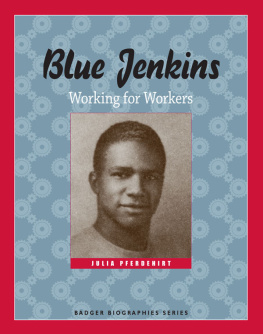Blue Jenkins

Other Badger Biographies
Belle and Bob La Follette: Partners in Politics
Blue Jenkins: Working for Workers
Caroline Quarlls and the Underground Railroad
Casper Jaggi: Master Swiss Cheese Maker
Cindy Bentley: Spirit of a Champion
Cordelia Harvey: Civil War Angel
Curly Lambeau: Building the Green Bay Packers
Dr. Kate: Angel on Snowshoes
Father Groppi: Marching for Civil Rights
Frank Lloyd Wright and His New American Architecture
Gaylord Nelson: Champion for Our Earth
Harley and the Davidsons: Motorcycle Legends
Joyce Westerman: Baseball Hero
Les Paul: Guitar Wizard
Lucius Fairchild: Civil War Hero
Mai Yas Long Journey
Mary Nohl: A Lifetime in Art
Mountain Wolf Woman: A Ho-Chunk Girlhood
Ole Evinrude and His Outboard Motor
A Recipe for Success: Lizzie Kander and Her Cookbook
Richard Bong: World War II: Flying Ace
Tents, Tigers, and the Ringling Brothers
Blue Jenkins
Working for Workers
Julia Pferdehirt
Wisconsin Historical Society Press
Published by the Wisconsin Historical Society Press
Publishers since 1855
2011 by the State Historical Society of Wisconsin
E-book edition 2013
For permission to reuse material from Blue Jenkins: Working for Workers (ISBN 978-0-87020-427-2; e-book ISBN 978-0-87020-657-3), please access www.copyright.com or contact the Copyright Clearance Center, Inc. (CCC), 222 Rosewood Drive, Danvers, MA 01923, 978-750-8400. CCC is a not-for-profit organization that provides licenses and registration for a variety of users.
wisconsinhistory.org
Photographs identified with WHi are from the Societys collections; address requests to reproduce these photos to the Visual Materials Archivist at Wisconsin Historical Society, 816 State Street, Madison,WI 53706.
Front and back cover photos: Courtesy of Betty Thomas
Cover and interior design by Jill Bremigan
Interior page composition by Biner Design
15 14 13 12 11 1 2 3 4 5
The Library of Congress has cataloged the printed edition as follows:
Pferdehirt, Julia, 1952
Blue Jenkins : working for workers / Julia Pferdehirt.
p. cm.(Badger biographies series)
Includes bibliographical references and index.
ISBN 978-0-87020-427-2 (pbk.) 1. Jenkins, William, 1916-1999. 2. African American labor leadersWisconsinRacineBiography. 3. Labor unionsOrganizingWisconsinRacineHistory. 4. African AmericansWisconsin RacineSocial conditions20th century. 5. Racine (Wis.)Race relations. 6. Racine (Wis.) Biography. I. Title.
HD6509.J46P44 2011
331.88092dc23
[B]
2011022842

On this day I am mindful of Blue Jenkins and a life dedicated to protecting the rights of workers through unions where every person has a voice. I dedicate this book to the teachers of the state of Wisconsin. Every day you help shape the next generation. Its impossible to thank you enough.

Publication was made possible, in part, by the Alice E. Smith Fellowship.

Contents
To Learn More about Blue Jenkins,
Workers Rights, and Civil Rights


On a few cold, wintry days in January of 1974, a historian from the Wisconsin Historical Society packed a tape recorder and notebooks into his car and traveled from Madison to Racine, Wisconsin, to meet William Jenkins. In his living room, William, called Blue by his friends and family, told a story that few people talked about in 1974. He told his own story. A story of growing up black in Wisconsin before the .
Blue told the story of his life. He talked about moving from the South with his family when he was less than a year old. Blues great-grandparents, and perhaps even his grandparents, lived in slavery. Blues parents hoped for a better life in a big northern city.
Blue talked about what it was like to grow up in a neighborhood where everybody knew everybodybut blacks were still invisible. He talked about what it was like to grow up in a school where he excelled at sportsbut couldnt always eat with the rest of the team when they traveled to games in other cities.
He talked about what it was like for his fatherand later himselfto work in a and working for workers to be treated fairly in their workplaces no matter what color their skin was. He talked about becoming a leader in that union and giving workers a chance to be heard.
Blue Jenkins lived during years of great change. He lived through the and three wars. He began working at a time when business owners could refuse to hire anyone black and nothing could be done about it.
Blue was part of the Civil Rights Movement. He knew what it was like to feel afraid of being hurt because he was speaking about equality. He knew what it was like to have to fight for things to be fair.
Blue became a respected leader, not only in the black community but also in Wisconsins labor unions. He worked to make unions accept black and white people equally.
Blue talked to the historian for more than 2 days. He filled tape after tape with stories of his life and experiences. He spoke about racism and friendship. About dancing to the music of the big bands and playing baseball every weekend. About fighting to get better jobs for black workers and about black and white workers together to get better jobs for everyone.
By sharing his life with us, Blue Jenkins gives us a way to understand what it was like to grow up black in Wisconsin 50, 60, or even 90 years ago. And he shows us how working for equalityin his community and in his workplaceis working for the good of people everywhere.

More than 90 years ago, good news came to Hattiesburg, Mississippi. Jobs! Factories and foundries in the North were looking for hard-working men.
Poor people in Mississippi, both black and white, worked long hours just to feed their families and have a place to live. In Hattiesburg, like much of the South, most land and businesses were owned by wealthy white men.
Many poor folks worked as coal miners. Others were . Sharecroppers didnt own farms. Instead, they rented their houses and fields from the landowners.
Every year sharecroppers would borrow money from the landowners. They bought seeds. They tilled and planted crops and worked from early in the morning to late in the evening.


















